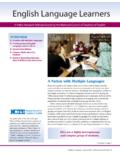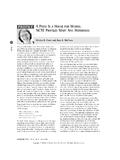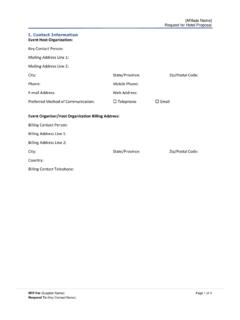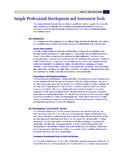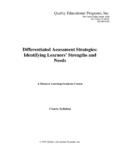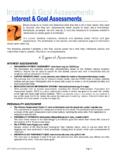Transcription of Formative Assessment That - NCTE
1 NCTE Assessment Task Force Chair: Cathy Fleischer, Eastern Michigan University, Ypsilanti Members: Scott Filkins, Champaign School District, IL. Antero Garcia, Colorado State University, Fort Collins Kathryn Mitchell Pierce, Wydown Middle School, Clayton, MO. Lisa Scherff, Estero High School, FL. Franki Sibberson, Dublin City Schools, OH. NCTE Staff Liaison, Millie Davis Permission is granted to reproduce in whole or in part the material in this publication, with proper credit to the National Council of Teachers of English. Because of specific local problems, some schools may wish to modify the statements and arrange separately for printing or duplication. In such cases, of course, it should be made clear that revised statements appear under the authorization and Formative Assessment That Truly Informs Instruction sponsorship of the local school or association, not NCTE.
2 This position statement may be printed, copied, and disseminated without permission from NCTE. Approved by the NCTE Executive Committee October 21, 2013. Effective teachers are constantly engaged in the process of Formative Assessment : offering one more bit of explanation from the Serafini, F. (2000/2001). Three paradigms of Assessment : Measurement, procedure, and inquiry. The Reading Teacher, , 384 393. front of the room when students ' heads tilt and brows furrow, asking a student to re-read a paragraph (this time aloud, maybe). when he shrugs at a question in a conference, handing a student her soon-to-be new favorite book based on the dozens of The author argues that as curriculum has developed from a series of facts to be memorized, to activities to be completed, to knowledge to conversations about the kinds of stories she likes and doesn't over the course of the year.
3 These acts of decision making, informed be constructed through inquiry, so has Assessment shifted from an act of measurement to a process of teacher and student inquiry. He by student response to purposeful or intuitive prompts, are the threads out of which skill, knowledge, and understanding are envisions teachers as active creators of knowledge about their students and offers practical suggestions for supporting teachers in this woven collaboratively by teachers and students . work, including providing time and support for shifting the purposes and audiences for Assessment . Formative Assessment can look more structured, too, with teachers Serafini, F. (2010). Classroom reading assessments: More efficient ways to view and evaluate your readers. Portsmouth, NH: Heinemann. Formative Assessment is the lived, daily beginning a class period with a discussion of a short list of general Serafini describes assessments as windows through which teachers observe their students , acknowledging that there are many windows embodiment of a teacher's desire to misunderstandings garnered from a recent quiz, grouping students with to choose from and all of them are limited in terms of what they allow us to see and understand.
4 The power of these Assessment refine practice based on a keener varied activities based on the writing they did the class period before, windows, in a context of inquiry, is that they help to make us better observers of students . The book is clearly organized with a wealth of or pairing students to read each other's drafts with a prepared list of understanding of current levels of practical examples and includes explanations of the research support for the practices he advocates. Chapter 2 provides an in-depth look at questions and prompts. In whatever shape it takes, Formative the processes and lenses teachers use as they generate Assessment information about their students . Throughout the book, Serafini student performance, undergirded by Assessment is the lived, daily embodiment of a teacher's desire to highlights the central role of the classroom teacher in the Assessment process.
5 The teacher's knowledge of possible refine practice based on a keener understanding of current levels of paths of student development within student performance, undergirded by the teacher's knowledge of nd Shagoury, R., & Power, B. (2012). Living the questions: A guide for teacher-researchers (2 ed.). Portland, ME: Stenhouse. the discipline and of pedagogies that possible paths of student development within the discipline and of pedagogies that support such development. At its essence, true Learning to use observations and careful study of student artifacts of learning is critical to being able to use Assessment to inform support such development. instruction. Shagoury and Power provide detailed examples of the ways teachers generate and collect information about their students . Formative Assessment is Assessment that is informing to teachers, The focus is on learning to look closely at students engaged in the learning process and at the work they create, in order to build a more students , and families.
6 Complex understanding of what students are learning and working at understanding. Although the primary purpose of the book is to support teacher-researchers, the stances and strategies are useful for teachers who do not see themselves as researchers, but who view Well over a decade into federal education policy that endows significant consequences to single tests of student achievement too Assessment through an inquiry stance. late in the academic year to lead to any action, teachers might be pleased that the term Formative Assessment is appearing in the broader discourse among test makers and publishers of educational materials. Teachers are very aware that frequent, in- Stephens, D. (2013). Reading Assessment : Artful teachers, successful students . Urbana, IL: NCTE. process checks for understanding are what allow them to teach better and improve student achievement, an awareness that has been supported by extensive research into Formative Assessment since the 1960s.
7 However, applying the term Formative Edited by Diane Stephens, this book offers portraits of elementary classroom teachers and literacy coaches as they use a variety of Assessment to those commercial products or tools that are sought out, purchased, or imposed by those least involved in the daily Formative assessments to improve reading practices of young students . As these literacy professionals show how and why they use multiple assessments, we watch them take control of their own classrooms as they use the results of those assessments to determine meaningful work of classroom learning raises serious concerns: Unless a Formative Assessment tool functions demonstrably as a lever for instruction for young readers. This book is part of NCTE's Principles in Practice imprint, based in the IRA-NCTE Standards for the Assessment meaningful teacher and student decision making, it is being marketed under erroneous pretenses.
8 While well-designed tools or of Reading and Writing. Assessment strategies are a key component to authentic Formative Assessment , if they are not what teachers consider the right tools for the immediate task at hand, they are frustrating and counterproductive. Tomlinson, C. (Dec. 2007/Jan. 2008). Learning to love Assessment . Educational Leadership, , 8 13. The sections that follow offer first a broad discussion of the many and varied purposes of Assessment , followed by an explanation In this brief and highly readable article, Tomlinson outlines the progression of her thinking about classroom Assessment . In explaining each of what Formative Assessment is and is not, highlighting the central importance of teacher decision making in the process of new critical insight, she helps teachers understand how reflecting on their practice can lead to more sophisticated understanding of the Assessment that informs instruction and improves student learning.
9 At the end, readers will find a checklist for decision makers teacher-learning process and the central role of informative Assessment in that process. Tomlinson stresses the value of adopting an considering the best ways to incorporate Formative Assessment into the learning cycle of students in their schools. Assessment as learning stance a stance that supports teacher learning as well as student learning. Tovani, C. (2011). So what do they really know? Assessment that informs teaching and learning. Stenhouse. Not All Formative Assessment Is Created Equal Teachers and schools assess students in a variety of ways for a variety of reasons from the broad categories of sorting, ranking, Tovani provides an in-depth look at the ways she assesses students in her classroom and what she has learned along the way about the and judging to the more nuanced purposes of determining specific levels of student understanding, restructuring curricula to meet Assessment process.
10 She divides Assessment into two categories: Formative Assessment that is designed to help her shape and adjust her student needs, and differentiating instruction among students . In the recent past, educators have made a strong distinction teaching and summative Assessment that is to determine what students have learned and where students are "ranked" on a particular skill. between summative Assessment (generally seen as a final evaluative judgment) and Formative Assessment (generally seen as The specific classroom examples and forms highlight the ways she gathers, organizes, reflects on, and uses this important data in order to ongoing Assessment to improve teaching and learning). However, in today's Assessment environment this distinction may be a plan for instruction. false one; in fact, many believe the difference between the two terms has more to do with how the data that is generated from assessments is actually used (Gallagher).
